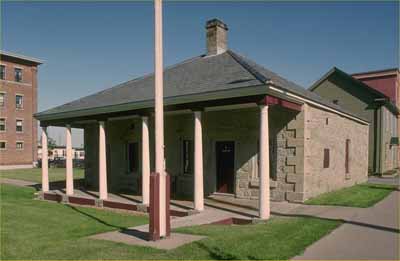Fredericton Military Compound National Historic Site of Canada
Fredericton, New Brunswick

View of Guard House
© Parks Canada Agency / Agence Parcs Canada, 1989
Address :
11 Carleton Street, Fredericton, New Brunswick
Recognition Statute:
Historic Sites and Monuments Act (R.S.C., 1985, c. H-4)
Designation Date:
1960-05-30
Dates:
-
1826 to 1882
(Construction)
-
1825 to 1825
(Significant)
-
1869 to 1869
(Significant)
-
1784 to 1784
(Established)
Other Name(s):
-
Fredericton Military Compound
(Designation Name)
-
Old Officers Square Barracks
(Historic Name)
-
Soldiers' Stone Barracks, Officers' Quarters, Militia Arms Store, Guard House
(Name of contributing resources)
Research Report Number:
1960-025, 2010-SDC-CED-018
Plaque(s)
Existing plaque: 11 Carleton Street, New Brunswick
This building is one of four remaining structures of the British establishment which housed the garrison at Fredericton from 1784 until the withdrawal of Imperial troops in 1869. Occupying the area between York and Regent Streets, the Compound enclosed over fifty buildings. The Soldiers' Stone Barracks (1826), Guard House (1828), Militia Arms Store (1832) and Officers' Quarters (1840 and 1853) survive as reminders of an important military establishment and its contribution to the early character and development of New Brunswick.
Description of Historic Place
Fredericton Military Compound National Historic Site of Canada is a military complex of four early 19th century buildings located in the Historic Garrison District of downtown Fredericton, New Brunswick. This military compound sits next to the majestic St John’s River. The complex includes the Soldiers’ Barracks, the Guard House, the Officers’ Quarters, and the Militia Arms Store. To the east of the Officers Barracks is an open, green space known as Officers Square that is approximately 70 by 90 metres. Additional buildings on the site were built in the late 19th and 20th centuries. Official recognition refers to a polygon bordered by Queen, Regent, and York streets in Fredericton.
Heritage Value
Fredericton Military Compound was designated a national historic site of Canada in 1960 because: the compound, which housed the British garrison at Fredericton from 1784 until 1869, was an
important military establishment that contributed to the early character and development of New
Brunswick; and, the surviving military buildings are representative of early 19th century British military
architecture.
The Fredericton Military Compound was established in 1784 as a British military garrison and at one point included over fifty buildings. Many of these buildings were destroyed in a fire in 1825 and extant military buildings were constructed afterwards. The British garrison occupied the Fredericton Military Compound until 1869 when the new Dominion of Canada assumed responsibility for defence. Only four buildings remain from the original British garrison: the Soldier’s Barracks (1826), the Guard House (1828), the Officer’s Barracks (1839, 1851) and the Militia Arms Store (1832). These buildings are representative of early 19th century British military architecture.
Character-Defining Elements
Key elements that contribute to the heritage character of the site include: - its location in downtown Fredericton, New Brunswick; - its strategic location on the south side of the St John River maintaining traditional riverfront access; - its distinctive institutional character in contrast to the commercial buildings on the opposite side of Queen Street south of the site; - its late 19th century cast iron fence enclosing the site; - the surviving early 19th century buildings which illustrate the historical function of the site; - its open spaces including trees and park amenities; - the integrity of any unidentified archaeological remains which may be found within the site in their original placement and extent.
Key elements that contribute to the heritage character of the Soldiers’ Barracks include: - its rectangular stone two and a half storey massing; - its gable roof and multiple dormers.
Key elements that contribute to the heritage character of the Guard House include: - its rectangular stone single storey massing, quality stonework and quoins; - its hipped roof; - its pillared walkway.
Key elements that contribute to the heritage character of the Officers’ Quarters include: - its rectangular stone three storey massing; - its gable roof; - the Roman arch arcade at ground level; - the open veranda on the second floor.
Key elements that contribute to the heritage character of the Old Militia Arms Store include: - its rectangular wooden two storey massing; - its steep roof, balanced facade and inset chimneys that speak to the Georgian style.